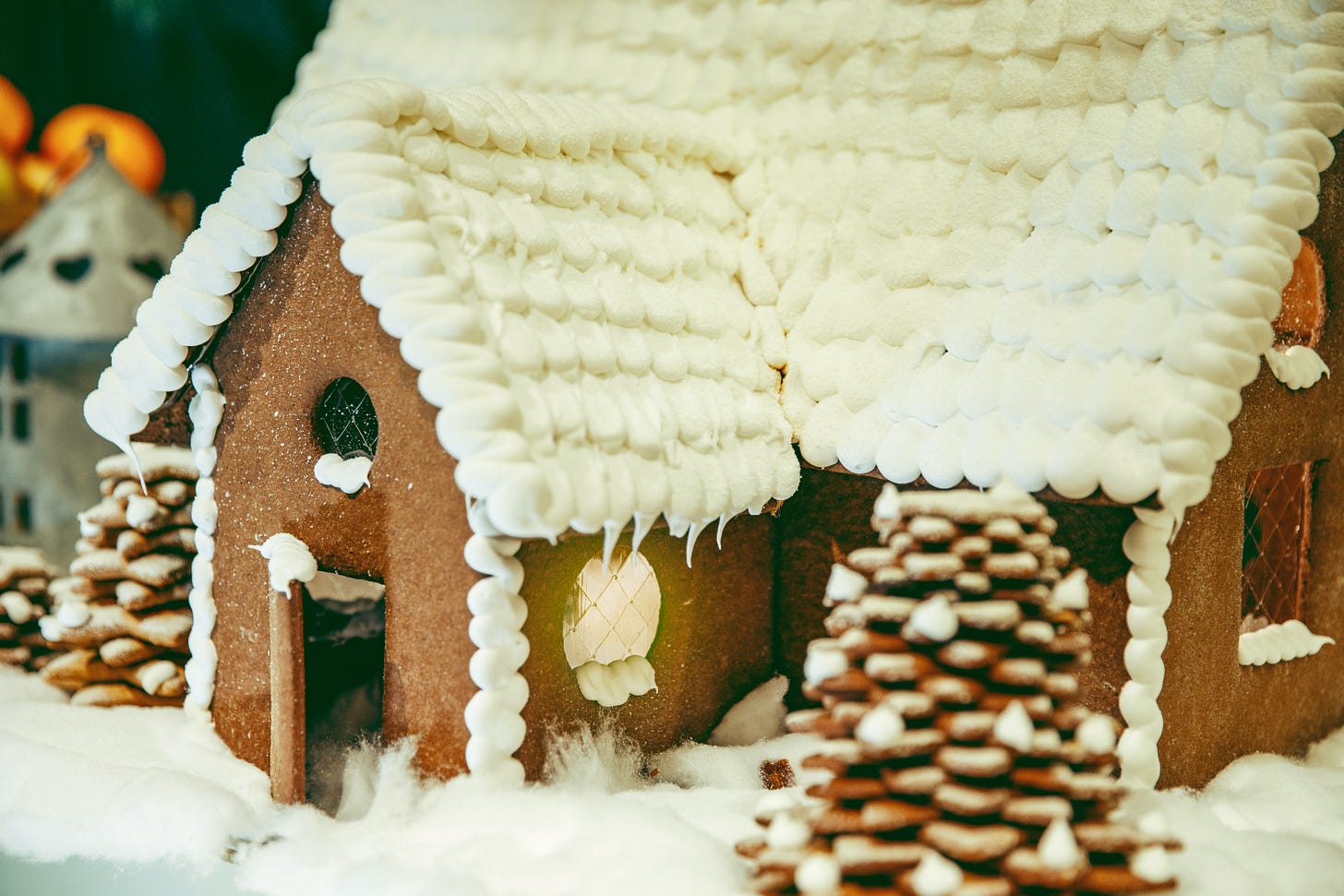When holiday time comes this sweet and spicy edifice is one of the most iconic of festive decorations and millions of kits are sold and made round the world. Gum drops and licorice, candy canes, sugared sprinkles and royal icing are all arrayed to make this enticing little structure: the sweet and sentimental centerpiece for families everywhere. For the more kitchen-ready folks, recipes are pulled out of drawers or old books and families gather in the kitchen to recreate this sweet monstrosity.
What a strange disconnect between holiday and horror.
In Europe, Gingerbread Houses have been around for many centuries. They existed long before the Grimm brothers published their first collection of Children’s and Household Tales. Hansel and Gretel, the story most associated with Gingerbread Houses was included in that first 1812 edition, and the public’s fascination for the sweet and murderous domicile has been unabated for over 200 years.
Hansel and Gretel have a tough story to tell. They are abandoned by their parents, not once but twice because of the prospect of a great famine. Fearing for their own futures, the parents, most notably the mother, plot to deliver the children to the woods where they can be safely left for the wild animals to devour. The first time, the children make it home by following the pebbles Hansel so cleverly dropped along the path. But the second time, birds eat the breadcrumb trail, and returning home is no longer possible. The children have nowhere to go but deeper into the forest.
There they meet a beautiful bird, one of the scoundrels who ate their passage home no doubt, but it sings so beautifully that they stop to listen. When the bird flies away they follow it till they come to a little cottage. There “they saw that the little house was built entirely from bread with a roof made of cake, and the windows were made of clear sugar.” They begin to eat.
You know the rest. An old woman comes out and is welcoming and kind. She feeds them wonderful food and tucks them into soft beds. As one edition describes it “they felt they were in heaven.” And for those few hours they were. Once morning comes, Hansel is locked in a cage and Gretel is forced into the kitchen to help prepare food to fatten Hansel for the witch’s dining pleasure.
There is no end of monstrous characters in Fairy Tale Land. And eating children is a particularly common occurrence. At first glance, what makes this witch and this story so horrific is the creation of the Gingerbread House and its role in ensnaring young, vulnerable and frankly starving children to their doom.
The other eaters are more ordinary. Jack’s Giant at the top of the Beanstalk is just a plain old carnivore. He eats what’s put in front of him. Despite all his Fee Fi Fo stuff, a little boy or a side of beef are all the same to him. Other terrible characters kill and cook children because they have agendas – like Snow White’s Queen and her all consuming jealousy, or the creepy stepmother in the Juniper Tree who is greedy and wants everything for her daughter and not for another woman’s son. The children are incidental to what drives these crazed adults to do their terrible deeds.
For the witch in Hansel and Gretel, the children are the entire point for everything she does. She has expended a lot of time and thought to what she wants. She takes pride in her little Gingerbread trap. She is in it for the sheer power and pleasure in capturing and torturing them. She doesn’t impatiently eat them or even ceremoniously prepare them as one might eat the heart of one’s enemy. She’s going to kill them but she’s going to make them participate in their own suffering. Hansel is first, and he is forced to eat the food he needs to live in order to hasten his own death. Gretel must prepare everything and then when her brother has been devoured, she will be next.
Yeeesh! How dark can one story get?
Today, when we bake the gingerbread or open the little house kits we are not usually remembering this aspect of the story. We don’t make the association. We are entranced by the whimsy of a building made from sweet treats. We are connected to the Wondrous, not the grisly reality of the children’s plight. We gloss over, quite literally, the details and enjoy the fantasy and fun. Nowadays, people have built whole cities of gingerbread or houses that are ten feet tall. They are magical and full of joy and these efforts are like many of the holiday decorations we embrace – a way to stave off the dark reminders of how cold and cruel the winter world can be.
We need Wonder. We crave it and keep it close because it gives us a sense of possibility, of Hope. When fairy tales are told they all contain hard-edged realities, slices of terrible doings by terrible people. But they are immersed in magical effects that enchant us and carry us through the darkness to the other side - the side of triumph and transformation.
This story of endangered children is served on a platter of sweet impossibility. If you can have a building made entirely of bread then you can certainly have two small children defeat a great and terrible evil. That’s reason enough to celebrate magic and whimsy, to make sweet Gingerbread Houses over and over again.
Photo by Urban Gyllstrom on Unsplash





What a wonderful piece. Thanks to Jackie for sending this to me. 🙂
Another gorgeous piece, Patty. This makes me want to write wonderous stories.